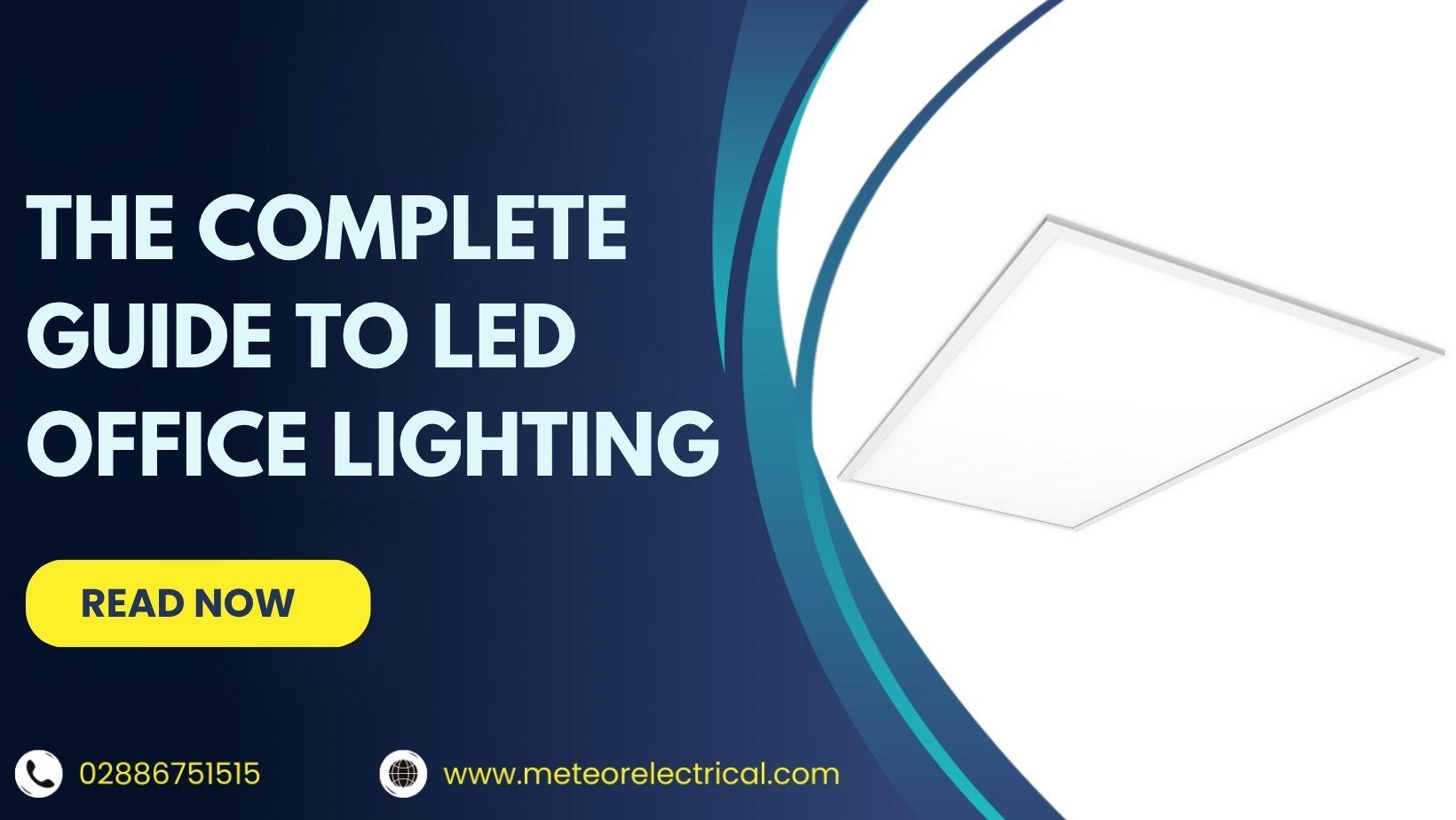The Complete Guide to LED Office Lighting: Benefits, Types & Why It’s a Must-Have for Modern Workspaces
The Complete Guide to LED Office Lighting: Benefits, Types & Why It’s a Must-Have for Modern Workspaces
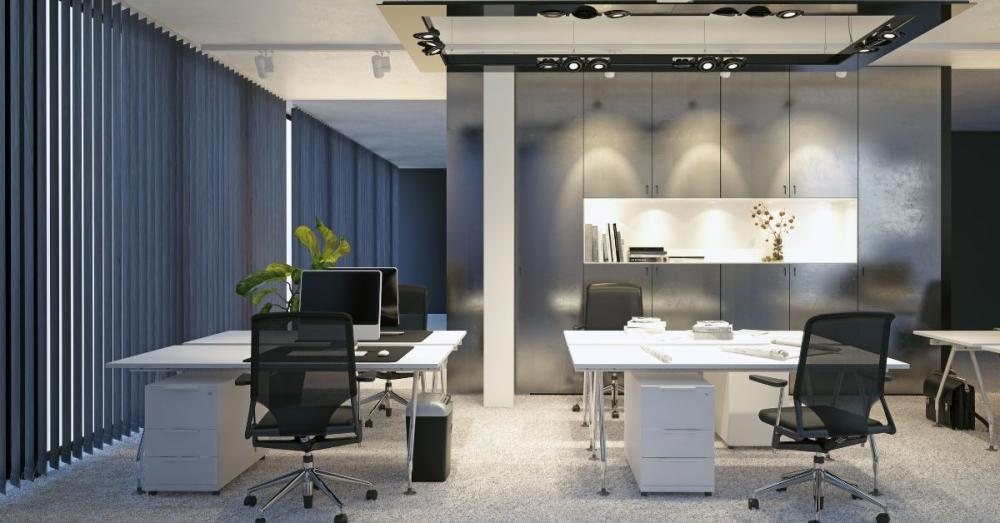
Office lighting is more than just flipping a switch, it's a cornerstone of a productive, healthy, and efficient work environment. Studies have shown that lighting significantly influences employee mood, productivity, and energy levels. Poor lighting doesn’t just make it hard to see; it can cause eyestrain, fatigue, and even long-term health issues. Conversely, a well-lit space encourages concentration, reduces stress, and can even foster creativity.
LED office lighting is quickly becoming the go-to solution for modern workspaces. It’s energy-efficient, long-lasting, and offers exceptional light quality. Whether you're designing a new office or upgrading an old one, understanding the fundamentals of office lighting design is critical. In this guide, we explore the benefits, options, and best practices of using LED office lighting to create an optimal workspace.
Why Is Good Office Lighting Important?
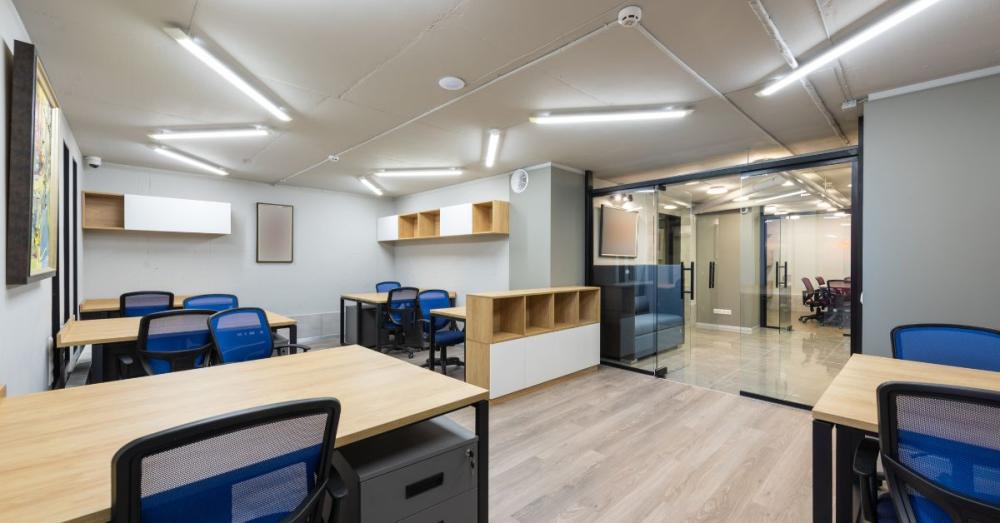
Before exploring specific lighting strategies, it’s important to understand why proper office lighting matters.
A well-lit workspace supports everything from visual clarity to employee morale. According to Health and Safety Executive (HSE), adequate lighting is a key element of workplace safety. Similarly, the International WELL Building Institute links proper lighting with better mental and physical health in the workplace.
In addition to safety, aesthetics play a crucial role. A thoughtfully designed lighting plan enhances your office's visual appeal and aligns with your company’s brand and culture. From a functional standpoint, it allows employees to perform tasks efficiently without strain.
Today’s workplaces must also consider cost and sustainability. This is where LED office lighting shines, both figuratively and literally. LEDs consume less power, last longer, and reduce both operational and maintenance costs.
Why Choose Energy-Efficient Office Lighting?
In an era where sustainability and cost-effectiveness are top priorities, energy-efficient lighting is a no-brainer.
Energy-efficient lighting solutions, like LEDs, are designed to use less electricity without sacrificing brightness. Unlike traditional bulbs that rely on fragile filaments, LED lights use semiconductors to emit light, making them far more durable and efficient.
It’s also worth noting that energy efficiency doesn’t equate to reduced performance. On the contrary, modern LED lights offer better light quality, consistent output, and lower lumen depreciation over time.
With the UK energy price cap surging up 54% in April 2022 and projected to rise further, energy-saving technologies are more crucial than ever. According to the UK Government's Energy Efficiency Strategy, the shift to efficient lighting could significantly cut carbon emissions and energy costs.
That’s why businesses across the UK are now prioritising commercial LED lighting to meet environmental goals and cut expenses.
Source- NM Cabling Solutions
What Are the Most Common Types of Office Lighting?

There are several lighting options available, but not all are suitable for offices, especially when energy efficiency and long-term costs are considered.
Incandescent Lighting
Incandescent bulbs are a relic of the past. These bulbs operate by passing electricity through a tungsten filament until it glows. While simple and inexpensive upfront, they’re highly inefficient.
Only about 10% of the energy consumed by an incandescent bulb turns into visible light, the rest is wasted as heat. They also have short lifespans and are prone to damage, making them an expensive choice in the long run.
For modern offices aiming to reduce overheads and environmental impact, incandescent lighting is a poor choice. It’s best reserved for decorative or temporary use.
Compact Fluorescent Lamps (CFLs)
Compact Fluorescent Lamps (CFLs) were once hailed as the efficient alternative to incandescent bulbs. They use 70–80% less energy and last up to 8,000 hours.
However, they come with downsides: they contain mercury, which is hazardous if broken and makes disposal more complicated. They’re also more likely to flicker, which can cause discomfort and eye strain.
In recent years, CFL lighting has lost ground to more advanced technologies like LEDs, which are safer, more reliable, and even more energy-efficient.
Light-Emitting Diodes (LEDs)
LEDs are the gold standard in modern office lighting. These solid-state devices emit light when an electrical current passes through a semiconductor. Unlike incandescent and CFLs, LEDs convert almost all their energy into light with minimal heat loss.
LEDs use up to 90% less energy than traditional bulbs and last 25 times longer. Their design also allows for directional lighting, meaning they illuminate exactly where needed, ideal for task lighting in workspaces.
Plus, LEDs do not contain harmful substances like mercury, making them safer and more eco-friendly. Many high-performance LED office lights come in adjustable colour temperatures and dimmable formats, offering even more control over your lighting environment.
LED Office Lighting vs. CFLs: What’s the Better Choice?
While both CFLs and LEDs are more efficient than incandescent options, LED lighting is far superior across all metrics.
- Lifespan: LEDs can last up to 50,000 hours; CFLs max out around 8,000 hours.
- Efficiency: LEDs convert more energy into light and less into heat.
- Durability: LEDs are solid-state and less likely to break.
- Environmental Impact: LEDs are non-toxic and recyclable; CFLs contain mercury.
- Light Quality: LEDs are more stable and less prone to flicker or warm-up times.
In terms of office energy efficiency, choosing LED lighting over CFLs offers a measurable return on investment in energy savings, reduced maintenance, and improved employee satisfaction.
Source- ThioJoeTech
What Are the Benefits of LED Office Lighting?
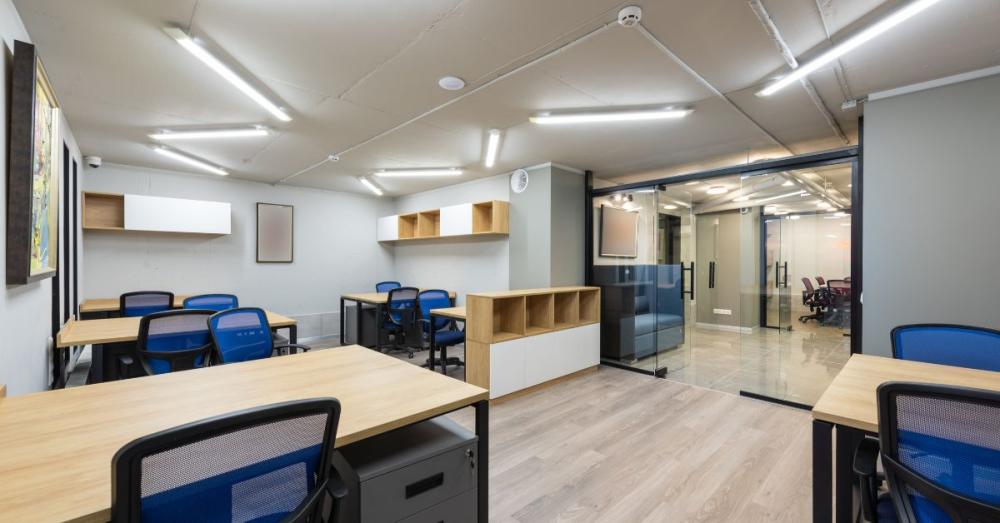
When investing in lighting solutions for your workplace, it’s important to understand the tangible advantages. LED office lighting offers numerous benefits that can significantly enhance the working environment.
Improved Productivity
Workspace design plays a pivotal role in influencing employee focus and morale. Employees spend a large part of their day indoors, so a poorly lit office can dampen motivation and reduce output.
A strategic lighting setup, especially one that incorporates natural light alternatives for offices, can create a more stimulating atmosphere. LEDs are available in colour temperatures that mimic daylight, helping regulate circadian rhythms and reduce fatigue. With adjustable lighting options, your team can customise their workspace to avoid glare and eye strain, boosting comfort and efficiency.
Advanced smart lighting systems can further enhance workspaces by offering controllable brightness levels, automation, and energy monitoring, ideal for modern office settings.
Better Energy Efficiency
One of the most notable advantages of LED lighting is energy efficiency for commercial spaces. These lights use a fraction of the power required by traditional lighting, significantly reducing operational costs over time.
Despite their low energy consumption, LED lights deliver high-lumen output, ensuring bright, consistent illumination. Their longer lifespan means fewer replacements and lower maintenance costs, ideal for businesses aiming for sustainability and cost control.
Versatile Design Options
Thanks to their compact structure and directional lighting capability, LED lights for office ceilings are available in a variety of styles to suit different layouts and functions. Whether you’re illuminating a high-traffic corridor or a personal workstation, LED fixtures can be tailored to your space.
You can install everything from panel lights to desk lamps or pendant fixtures, all with adjustable brightness and colour temperatures. LEDs also work well in non-traditional environments like warehouses, offering robust performance and broad light distribution.
Environmentally Friendly
In today's eco-conscious world, many businesses are adopting greener technologies. LED office lighting contributes significantly to sustainability efforts.
LEDs are free from toxic materials such as mercury and lead, and they're fully recyclable. Furthermore, their energy-efficient design lowers carbon emissions, aligning with many companies’ environmental, social, and governance (ESG) targets.
Long-Lasting and Durable
Durability is another key benefit of LED lighting. Unlike incandescent or fluorescent bulbs, LEDs don’t contain filaments, which makes them more shock-resistant and less prone to breakage.
The solid-state build of LEDs ensures long-term functionality even in demanding work environments. This robustness means reduced downtime and fewer replacements, saving you time and money in the long run.
Reduced Health Risks
A healthier work environment starts with good lighting. Flickering fluorescent bulbs are known to trigger headaches and eye strain. LED office lighting provides flicker-free, high-quality light that closely resembles natural sunlight.
By improving visual comfort and reducing stress, LEDs contribute to better employee well-being and fewer sick days, making them an investment in your team’s health.
What Are the Different Types of Lighting You Can Use in Offices?
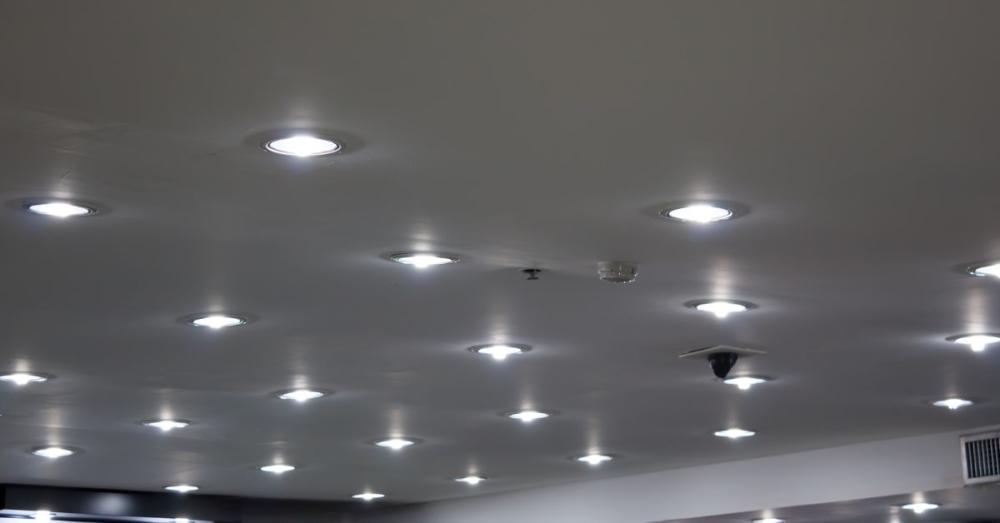
Each office space has varying needs when it comes to lighting. Different zones, such as workstations, meeting rooms, or lounges demand distinct levels and types of illumination. Thankfully, LED lighting can accommodate every requirement.
Ambient / General Lighting
Ambient lighting provides the base layer of light in any room. It creates overall visibility, allowing employees to navigate spaces safely and comfortably.
In an office setting, ambient lighting can be achieved with recessed downlights, track lighting, or overhead LED panels. A cooler white tone is often preferred in workspaces to enhance alertness and productivity.
Task Lighting
Task lighting for offices focuses on localised areas where detailed work is performed, such as at desks or workbenches. These fixtures offer direct, adjustable illumination to prevent shadows and eye strain.
Common types include desk lamps and under-cabinet lights. For maximum efficiency, LED desk lamps offer focused brightness, adjustable arms, and low heat output, making them an ideal option for modern office setups.
Accent Lighting
Accent lighting is primarily aesthetic, designed to draw attention to certain elements like wall art, branded signage, or architectural features. Though often overlooked, adding accent lighting to your office can create a more dynamic and engaging environment.
Wall-mounted sconces, picture lights, and strip LEDs can all serve as effective accent lights that boost the space’s visual appeal without overwhelming functionality.
Office-Specific Lighting Solutions
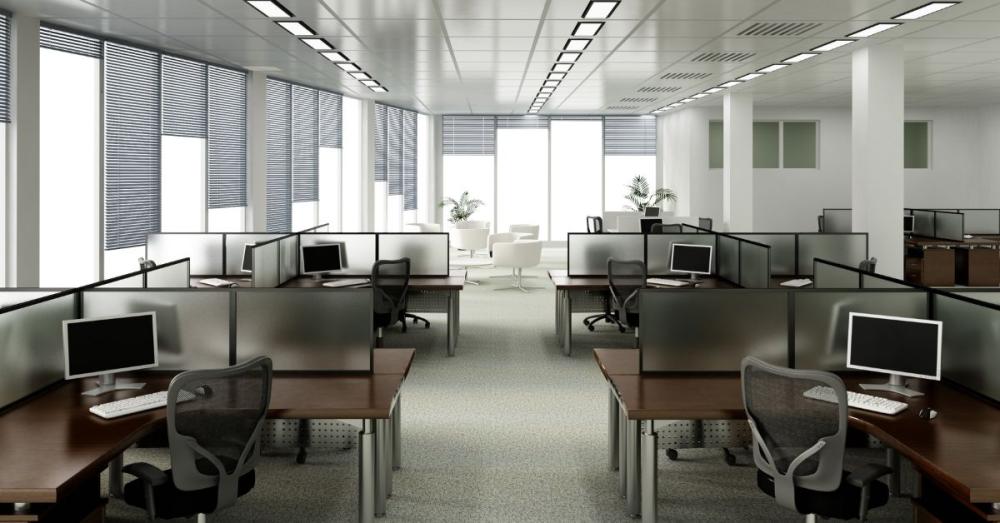
Beyond general types, there are several specialised LED office lighting solutions that cater specifically to business environments.
LED Flat Panel Light Fixtures
Flat panel LEDs are a sleek, space-efficient choice for delivering widespread, even light. Installed flush within the ceiling grid, these fixtures offer clean aesthetics and are particularly suited to large, open-plan offices.
Available in both square and rectangular formats, panel lights typically come in two types:
- Back-Lit Panels: LEDs are placed behind the panel, producing uniform light through a diffuser. These are cost-effective and widely used.
- Edge-Lit Panels: LEDs are positioned around the perimeter of the panel. These are thinner, more elegant, and ideal for premium office settings, though they consume slightly more power.
Suspended LED Lighting
Suspended or pendant LED lights add both function and design to workspaces. Their adjustable hanging length makes them great for creating focused lighting over desks or communal tables.
They’re commonly used in creative spaces and modern offices where architectural style is as important as utility.
Recessed LED Lighting
Recessed lighting is mounted within ceiling cavities to deliver a sleek and modern appearance. These lights provide direct downward illumination and are ideal for smaller offices or corridors where space is limited.
LED recessed lights offer strong intensity and efficiency while helping make the room appear larger and more streamlined.
What Standards Should You Follow for Office Lighting?
In the UK, there are specific health and safety lighting guidelines outlined under The Workplace (Health, Safety and Welfare) Regulations 1999. Employers are required to ensure sufficient and appropriate lighting for tasks and movement.
General Lighting Requirements
When planning lighting for your office, you should consider:
- Existing natural and artificial light sources.
- The brightness and type of fixtures.
- The layout and nature of work conducted in each area.
The goal is to ensure every employee can safely perform their duties without discomfort or risk of injury.
Task-Specific Standards
Lighting should be tailored to the complexity of a given task. For instance:
- 160–240 lux is adequate for reading and light administrative tasks.
- 400–600 lux is recommended for more detailed tasks like technical drawing or data analysis.
Using a lux meter helps maintain accuracy and ensures compliance with lighting levels appropriate for various work types.
Emergency Lighting Standards
Emergency lighting is crucial for employee safety during power outages or evacuations. These lights must illuminate escape routes, stairs, and exit signs and should be backed by a reliable battery source capable of functioning independently when the main power supply fails.
For additional details, consult the UK’s Health and Safety Executive guidance on lighting in the workplace.
What Is the Best Colour Temperature for LED Office Lighting?
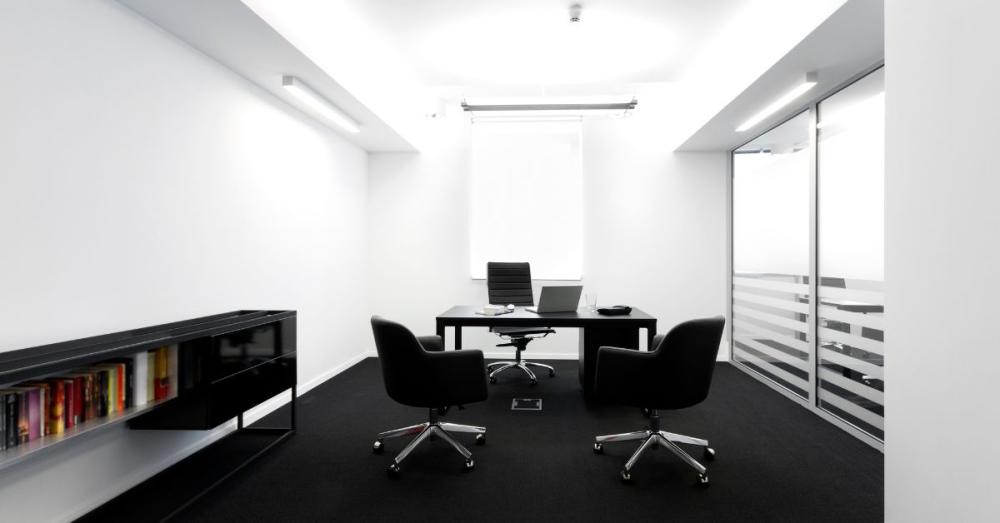
Colour temperature is expressed in Kelvins (K) and determines the hue of your light source:
- 2700K–3000K: Warm white – ideal for relaxed spaces.
- 4000K–5000K: Neutral/cool white – best for productive office environments.
- 5000K–6500K: Daylight – simulates natural sunlight and is excellent for detailed tasks or creativity-based roles.
Most offices benefit from LED lights with colour temperatures between 4000K–5000K, offering a clear, crisp light that supports alertness without causing fatigue.
To support your lighting plan, explore LightingEurope’s standards for indoor lighting design and CIBSE guidelines for lux levels.
Final Takeaway: Why Choose Meteor Electrical for LED Office Lighting?
Office lighting is far more than a functional necessity, it’s a strategic tool that can improve employee productivity, health, and energy efficiency. With the right setup, you can transform your workplace into a high-performance environment that supports both people and business goals.
LED office lighting checks all the right boxes. It’s cost-effective, environmentally friendly, versatile, and supports better employee wellbeing. Whether you’re revamping an old office or designing a new one, switching to LED will help you achieve sustainable, long-term benefits.
At Meteor Electrical, we offer a comprehensive range of LED office lighting solutions to suit every type of commercial space, from flat panel lights to suspended fixtures, task lamps, and emergency lighting. We combine quality, efficiency, and compliance so you can light up your workspace confidently.
Ready to upgrade your office lighting? Explore our full selection of LED products today and experience the Meteor Electrical difference.
FAQs:
1. What is the best lighting for office productivity?
The best lighting for office productivity is LED office lighting with a colour temperature between 4000K and 5000K, as it mimics natural daylight. This type of lighting helps improve focus, reduce eye strain, and support alertness throughout the workday.
2. Are LED lights better than fluorescent lights for offices?
Yes, LED lights are better for office use than fluorescent lights. LEDs are more energy-efficient, have a longer lifespan, emit less heat, and do not flicker, making them healthier and more cost-effective in the long term.
3. How does office lighting affect employee performance?
Proper office lighting, especially natural or daylight-mimicking LED lighting, improves concentration, reduces fatigue, and supports mental wellbeing. Poor lighting, on the other hand, can lead to eye strain, headaches, and decreased productivity.
4. What are the most energy-efficient lights for offices?
LED lights are currently the most energy-efficient lighting option for offices. They consume up to 90% less energy than incandescent bulbs and significantly less than fluorescent alternatives while providing the same or better light output.
5. What is the recommended lux level for office lighting?
For general office tasks, the recommended lux level ranges from 300 to 500 lux, depending on the task's complexity. Higher lux levels may be required for technical or detailed work, such as drafting or design.
6. Can LED lighting reduce office energy bills?
Absolutely. Switching to LED office lighting can reduce your electricity bills by up to 70%, thanks to lower power consumption and reduced maintenance costs. This makes LEDs a smart investment for any workplace.
7. What are the different types of LED office lighting?
Common types of LED lighting for offices include:
- LED flat panel lights
- Recessed LED lights
- Suspended LED fixtures
- LED desk lamps
- Task and accent lighting
Each serves a different function and can be used to enhance visibility, design, and productivity.
8. What is the ideal colour temperature for LED office lights?
The ideal colour temperature for office LED lighting is between 4000K and 5000K. This neutral to cool white range closely resembles natural daylight and helps boost employee alertness and visual comfort.
9. How long do LED office lights last?
LED lights for offices typically last 25,000 to 50,000 hours, depending on the quality and usage. This is significantly longer than incandescent or fluorescent bulbs, reducing replacement frequency and maintenance costs.
10. Why should businesses switch to LED lighting?
Businesses should switch to LED office lighting solutions to benefit from:
- Lower energy consumption
- Reduced maintenance
- Better employee wellbeing
- Environmentally friendly technology
- Compliance with UK safety standards
LEDs are a smart, future-proof choice for any forward-thinking business.

